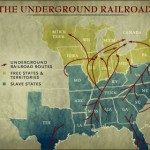A three-mile stream meandering through a park in Carroll County is all that remains of what was once the longest canal in the northern hemisphere. Inspired by George Washington’s idea that the eastern seaboard be linked to the country’s interior via a system of waterways, early Indiana leaders set about the construction of the Wabash and Erie Canal. The project, buoyed by the success of New York ‘s Erie Canal, would provide a route to transport raw materials, manufactured goods, and people through the heavily forested state. In 1827, the federal government designated a corridor of riverside acreage for the canal. By 1832, a crew of largely Irish immigrants had begun construction in Fort Wayne –at the junction of the Wabash and Maumee Rivers. Over the next twenty years, they would clear a sixty-foot swath and dig a four-foot trench ultimately connecting Toledo, Ohio and Evansville, Indiana. At 468 miles upon completion, the Wabash and Erie Canal was part of the second-longest canal system in the world, providing the missing link between New York and New Orleans.
Mules and horses treading along the canal’s towpath pulled packet and line boats loaded with freight or passengers at a rate of four to eight miles an hour. Those needing to stretch their legs would sometimes disembark at one of the canal’s locks, and catch up with the vessel at its next stop. The ease of constructing a canal craft and making one’s way west proved appealing to the pioneer mentality. The canal quickly invigorated the state’s commerce and population and led to the growth of Peru, Lafayette, Terre Haute and other cities along the canal’s route.
The canal’s early success led to the legislature’s passage of the Internal Improvement Act of 1836. The act mandated a comprehensive transportation infrastructure, including the Whitewater Canal in southeastern Indiana, and the Central Canal through Indianapolis. Construction hinged on a loan of ten million dollars, however, and the national economic panic of 1837 brought the plan crashing down. Projected to span 296 miles, the Central Canal never went further than eight miles through Indianapolis. Floods, vandalism and the rise of train travel, along with the changes wrought by the Civil War, ultimately sounded the death knell for the canals. One of the last barges to make its way down the Wabash and Erie Canal was destroyed–and its crew drowned–when a decrepit aqueduct collapsed under it in 1874. Though a railroad bought the canal right of way soon thereafter, the legacy of the canal era was permanent. The state’s population had increased seven-fold over the canal’s existence, and Indiana ‘s constitution still includes a provision forbidding indebtedness.
For more information:






















